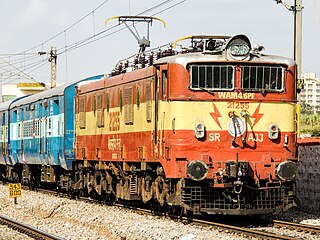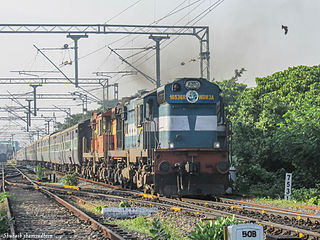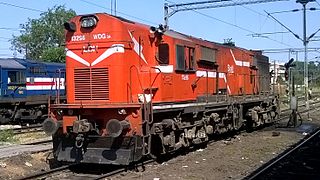
The Indian locomotive class WDM-2 is a class of diesel-electric locomotive that was developed in 1962 by American Locomotive Company (ALCO) for Indian Railways. The model name stands for broad gauge (W), Diesel (D), Mixed traffic (M) engine, 2nd generation (2). They entered service in 1962. A total of more than 2,700 WDM-2 was built at ALCO and Banaras Locomotive Works, Varanasi between 1962 and 1998, which made them the most numerous class of mainline diesel locomotive until its successor the WDM-3A.

The Indian locomotive class WAM-4 is a class of 25 kV AC electric locomotives that was developed in 1970 by Chittaranjan Locomotive Works for Indian Railways. The model name stands for broad gauge (W), alternating current (A), mixed traffic (M) locomotive, 4th generation (4). They entered service in March 1971. A total of 500 WAM-4 were built at CLW between 1970 and 1983, which made them the most numerous class of mainline electric locomotive till its successor the WAG-5.

The Indian locomotive class WDP-4 is a passenger-hauling diesel-electric locomotive with AC electric transmission designed by General Motors Electro-Motive Division and built by both GM-EMD and under license by Banaras Locomotive Works (BLW) of Varanasi, India for Indian Railways as the classes WDP4, WDP4B and WDP4D. The GT46PAC is a passenger version of the previous Indian Railways EMD GT46MAC freight locomotive. The locomotive has a 16-cylinder 710G3B diesel engine and is one of the fastest diesel-electric locomotives in service in Indian Railways.
The ALCO DL560C is a series of diesel-electric locomotive with AC electric transmission designed by the American Locomotive Company and produced under license by Banaras Locomotive Works (BLW) Varanasi, India for Indian Railways as their classes WDM-2, WDM-3A/2C, WDM-3D and WDG-3A for operation in India. The locomotive is fitted with a 16-cylinder ALCO 251 B,C diesel engine. In the early 1960s Indian Railways needed a reliable diesel workhorse to gradually replace its steam locomotive fleet. Equal numbers of ALCO's DL560C and EMD's G16 were chosen for trials. More locomotives of each of these were purchased for more trials. Indian Railways was keen on producing these locomotives in the country rather than depending on imports. EMD did not agree for a Transfer-of-Technology, while ALCO did. Thus ALCO DL560C was chosen for the job due to its easy maintenance, reliability and simple operation. And from then on vast numbers of this loco in different configurations have been produced and remain the main diesel traction power of Indian Railways.

The Indian locomotive class WCAM-2 is a class of dual-power AC/DC series electric locomotives that was developed in 1995 by Bharat Heavy Electricals Limited used in the Indian Railways system. They are the second locomotive from the WCAM class. The model name stands for broad gauge (W), DC Current (C), AC Current (A), Mixed traffic (M) locomotive, 2nd generation (2). They entered service in 1995. A total of 20 WCAM-2 were built at BHEL between 1995 and 1996, which made them the most numerous class of mainline dual-power AC-DC electric locomotive. They use the same motors as WCAM 1 but with different circuitry and gearing. They are operational in routes around Mumbai. MU operation was possible with 3 units. WCAM-2P was the passenger-oriented version of the WCAM-2 class. However, they perform better than the WCAM 1 series.

The Indian locomotive class WDM-4 is a class of diesel-electric locomotive that was developed in 1962 by Electro-Motive Diesel for Indian Railways. The model name stands for broad gauge (W), Diesel (D), Mixed traffic (M) engine, 4th generation (4). They entered service in 1962. A total of 72 WDM-4 locomotives were built between 1961 and 1962.

The Chennai Central – Bangalore City line is an electrified railway double line which connects Chennai and Bengaluru, the two largest cities in South India. It is officially known as Puratchi Thalaivar Dr. M.G. Ramachandran Central Railway Station–Krantivira Sangolli Rayanna line, and earlier known as Madras–Bangalore line.

The Indian locomotive class WDM-3A is a class of diesel–electric locomotive that was developed in 1993 by Banaras Locomotive Works (BLW), Varanasi for Indian Railways. The model name stands for broad gauge (W), Diesel (D), Mixed traffic (M) engine, with 3300 horsepower (3A). The WDM-3A is a later classification of earlier WDM-2C. They entered service in 1994. A total of 143+ were built at ALCO and Banaras Locomotive Works between 1994 and 2003 with rest of the 1246 units being rebuilt from WDM-2 which made them the most numerous class of mainline diesel locomotive until the WDG-4.

The Varanasi–Jaunpur City–Sultanpur–Lucknow line is a railway line connecting Varanasi and Lucknow, both in the Indian state of Uttar Pradesh. This line is under the administration of Northern Railway and Lucknow Charbagh Divisions.

TheYDM-4 is a class of diesel locomotives operating on Indian Railways. The first units were built by the American Locomotive Company (Alco) in 1961. Since 1968, members of the class have been manufactured in India by the Banaras Locomotive Works (BLW), Varanasi. The model name stands for metre gauge (Y), diesel (D), mixed traffic (M) engine. The YDM-4 has been the most successful metre gauge diesel locomotive in India. The YDM-4 locos have a maximum speed of 100 km/h (62 mph), restricted to 85 km/h (53 mph).

Diesel Loco Shed, Ernakulam (Code:ERSX) is a motive power depot performing locomotive maintenance and repair facility for diesel locomotives of the Indian Railways, located at Ernakulam Junction (ERS) of the Southern Railway zone in the city of Kochi, Kerala. It is one of the four diesel loco sheds of the Southern Railway, the others being at Tondiarpet (TNP) at Chennai, Erode (ED) and Golden Rock (GOC) at Trichy and the only locomotive shed in Kerala and the southernmost loco shed in India. Although it is in Kerala, its locomotives were mainly used in Goa and Maharashtra, and very rarely near the shed for passenger trains.

The Indian locomotive class WDM-3D is a class of diesel-electric locomotive that was developed in 2003 by Banaras Locomotive Works (BLW), Varanasi for Indian Railways. The model name stands for broad gauge (W), Diesel (D), Mixed traffic (M) engine with 3300 horsepower (3D). The engine is classified WDM-3D though it outputs only 3300 hp and not 3400 hp as the name should suggest. They entered service in 2003. A total of 590+ WDM-3D were built at Banaras Locomotive Works (BLW), Varanasi between 2003 and 2016.

The Indian locomotive class WDP-1 is a class of diesel-electric locomotive that was developed in 1995 by Banaras Locomotive Works (BLW) for Indian Railways. The model name stands for broad gauge (W), Diesel (D), Passenger traffic (P) engine, 1st generation (1). They entered service in 1995. A total of 69 WDP-1 units were built at Banaras Locomotive Works (BLW), Varanasi between 1995 and 1999.

The WDM-7 is a diesel-electric locomotive of Indian Railways. It has been manufactured by Banaras Locomotive Works (BLW), Varanasi. The model name stands for broad gauge (W), diesel (D), mixed traffic (M) engine. Today, these are found exclusively at Chennai Central and nearby area.

The Indian locomotive class WDG-3A is a class of diesel-electric locomotive that was developed in 1994 by Banaras Locomotive Works (BLW),Varanasi for Indian Railways. The model name stands for broad-gauge (W), Diesel (D), Goods traffic (G) engine, 3,100 hp (3A) locomotive. They entered service on 18 July 1995. A total of 1,164 WDG-3A units were built between 1994 and 2015 at BLW, Varanasi with a few units being produced by Diesel Loco Modernisation Works (DLMW) and Parel Workshop.

The Indian locomotive class WCG-2 is a class of 1.5 kV DC electric locomotives that was developed in the late 1960s by Research Design and Standards Organisation (RDSO) and Chittaranjan Locomotive Works (CLW) for Indian Railways. The model name stands for broad gauge (W), DC Current (C), Goods traffic (G) engine, 2nd generation (2). They entered service in February 1971. A total of 57 WCG-2 were built at CLW between 1978 and 1983, which made them the most numerous class of DC electric locomotive.

The Indian locomotive class YDM-5 is a class of diesel-electric locomotive that was developed in 1964 by General Motors (GM-EMD) for Indian Railways. The model name stands for Metre gauge (Y), Diesel (D), Mixed traffic (M) engine, 5th generation (5). They entered service in 1964. A total of 25 YDM-5 locomotives was built between 1963 and 1964.
The Indian locomotive class YDM-3 is a class of diesel-electric locomotive that was developed in 1964 by GM-EMD for Indian Railways. The model name stands for Metre gauge (Y), Diesel (D), Mixed traffic (M) engine, 3rd generation (3). They entered service in 1962. A total of 30 YDM-3 locomotives was built between 1961 and 1962.

Diesel Loco Shed, Tondiarpet is a motive power depot performing locomotive maintenance and repair facility for diesel locomotives of the Indian Railways. It is located near Tondiarpet railway station (TNP) of the Southern Railway zone in the city of Chennai, Tamil Nadu and is one of the four diesel loco sheds of the Southern Railway, the others being at Ernakulam (ERS) at Kochi, Erode (ED) and Golden Rock (GOC) at Trichy.
The WDM-2G is a class of diesel electric genset locomotive used in Indian Railways. It is one of the rarest locomotives in India with only two units being produced by Patiala Locomotive Works (PLW). The locomotives were produced with an intention of being fuel efficient and to be used for light to medium duties such as short passenger runs along with occasional shunting. They are one of the only two classes of locomotives in India to feature multiple prime movers, the other example being WDS-6G, which was designed solely for shunting. They have a rated power of 2,400 HP.






















